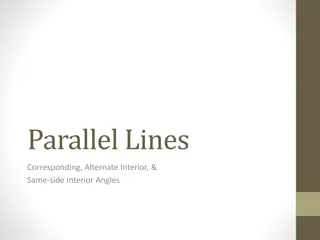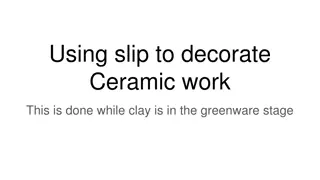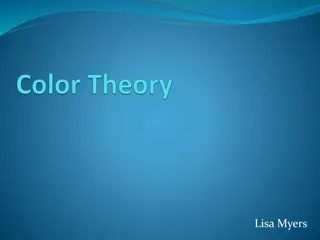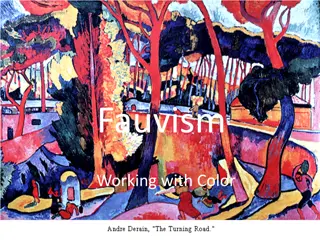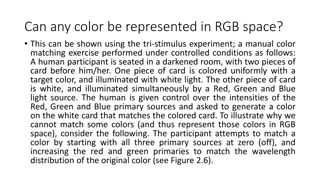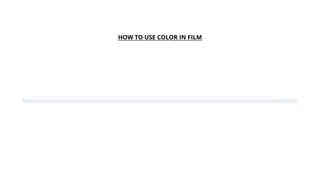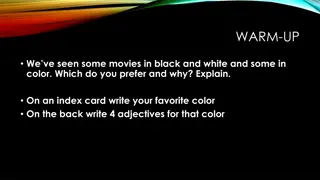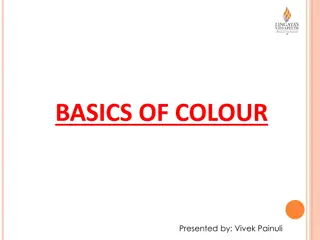Understanding Color: Characteristics, Color Wheel, and Interior Decoration
Color is a vital aspect of our everyday lives, evoking various emotions and perceptions. This article delves into the characteristics of color, the color wheel, color schemes, and the use of color in interior decoration. It explains how colors are perceived, the qualities of color like hue, value, and intensity, and the effects of warm and cool colors. Understanding these principles can help in creating harmonious and aesthetically pleasing color schemes for interior spaces.
Download Presentation

Please find below an Image/Link to download the presentation.
The content on the website is provided AS IS for your information and personal use only. It may not be sold, licensed, or shared on other websites without obtaining consent from the author. Download presentation by click this link. If you encounter any issues during the download, it is possible that the publisher has removed the file from their server.
E N D
Presentation Transcript
Characteristics, Color Wheel, Color Schemes, Use of color in Interior Decoration
We all live in a world where color is a part of us. Color in everyday life is very diverse. It gives us pleasure, increase our appetite and provide us serenity. Color is a mental phenomenon which is evoked by light striking the back of the eyes. An object does not have any color of its own rather its color is determined by its ability to absorb light waves because all objects do not absorb light equally there different colors are produced.
If an object absorbs all colors except red then the red color is reflected to the eye and the object looks red. White surface reflects all the colors and absorbs none but in black surface all the colors are absorbed and none is reflected. White light is a mixture of all colors. When sunrays fall on the round surface of the raindrops, these colors appear in the form of rainbow. Same effect can be produced by passing through prism.
After passing through prism light is divided into seven colors arranged in a particular order known as spectrum. There arrangement of colors is denoted as VIBGYOR
Qualities Of Color; 1. Hue >Indicates name of a color egg. red, blue, green etc 2.Value>refers to amount of lightness or darkness. Lightest value is white and darkest value is black. Tint>Red+White=Pink Shade>Red+Black=Maroon Tone>Red+Black+White=Greyed version of red
Intensity>Also known as chroma. Refers to as brightness or dullness of colour.Bright colours are full of life and dull colours are subtle
Based on Effect:- Warm and cool colors Some colors such as red orange, red purple, etc give feeling of warmth while others such as green, blue purple give a cool effect Yellow color will feel warm when used with red and orange but will give a cool effect when used with blue or green. In a color wheel almost half of the colors are warm and half are cool. Warm colors are colors of sunshine and cool colors are associated with sky, water, ice and foliage.
Warm colors can be used for rooms facing north or in cold regions and cool colors are good houses facing south or west direction. Heaviness and lightness Some colors appear to be light and some appear to be heavy. Colors with deep value such as deep purple, deep red seem heavy in interior decoration. Colors with low value such as light blue, yellow green seem lighter. Heavy colors are mostly used for flooring and furniture, i.e. dark colors can be used for carpet, sofa cover etc. and also for men s room. Light colors can be used for walls curtain ceiling and also for woman and children s room
Advancing or Receding colors Depending upon intensity and value, colors have the ability to attract attention. Warm colors such as yellow, orange and red, etc. seem to advance and cool colors such as blue, green, etc. seem to recede In interior decorations, advancing colors appear to make a room small and cool colors appear to make a room spacious. In a rectangular room if the long walls are colored with warm colors and short walls are colored with cool colors the room will look like a square
Earth Colors-Earthy colors are made from earth such as deep umber and yellow ochre. Vegetable dyes have the earthy character.
Colors have different psychological effects, positive as well as negative. This point must be kept in mind while choosing colors in your design since various colors convey varied meanings. Red Red Red is the color of energy, it s bold, it s powerful, it s vibrant. It has the longest wavelength (the distance over which the wave s shape repeats). It s the color of effectiveness, excitement and liveliness. All over the world we follow red traffic light to stop, its visibility is the strongest amongst all other colors because of its highest wavelength. On the other hand its negative impacts can be aggression, visual disturbance and strain. You live in a red room for a day and you will go crazy, it has to be complimented with other colors to make it subtle.
Blue Blue Blue is the color of intelligence, vastness, royalty, serenity, coolness and tranquility. Sky appears blue and gives calm effect, water appears blue and gives peace of mind. Blue appears to be the favorite color of most of the people but on the other hand it is also a color of coldness, unfriendliness and unemotional. Green Green Green is the most refreshing and cool color. Green is the color of life, fertility, reassurance, peace, harmony, balance. Nature is green and how soothing it is to our eyes. Not a single tree in this world is of the same green tint or shade, yet it appears to be so full of life and create environmental beauty. As for its negative traits it is the color of Boredom, stagnation, blandness and enervation.
Violet Violet is color of truth, luxury and spiritual awareness. It has the shortest wavelength therefore it is considered to be weak also. A color of introversion and suppression. It is associated with deep contemplation and royalty, meditation and quality. Orange Orange gives warmth, comfort, security, passion, fun and frolic. Due to the mixture of red and yellow it gives stimulation and sensuality. Use of too much orange gives a feeling of no serious attitude and gives a feeling of deprivation if used with black. Black All colors are absorbed in black. Black is glamorous, graceful, efficient and security. Women wear black to attract, they look sophisticated. Black creates hindrance since there s no light no reflection. It works perfectly with white thus the co relation is either alternation or repetition. Black is the color of mourning also. Too much black creates heaviness and scary look. Violet Orange Black
Yellow Yellow Yellow is a very emotional color, it is the color of self esteem, confidence and optimism. After red yellow has the longest wave length, appearing to be strong from a distance. World over yellow cabs can easily be seen, sunflowers, daffodils appear to be friendly. Contrary to this it also communicates few negative values like depression, hatred and anxiety. Pink Pink Pink is a cute color, very feminine, love and tranquility. Though pink is a tint of red but it soothes rather than stimulates. It gives comfort and suggests grace and elegance. Sometimes too much pink looks physically weak and appears full of flaws. It creates impact of inhibition.
White White is pure, clean, hygienic, innocent and simple. White is total reflection. It gives perception of space, too much clutter in a design can be overcome by using spaces of white. The negative effect of white is that it makes other colors used with it cold and unfriendly. Can create a diminishing effect. White Grey Grey is a neutral color, not giving a direct psychological effect. It may represent emptiness and dullness. It gives impression of dampness and right tone of grey must be used otherwise it may make your composition depressive. Grey
There are three primary colors, Red, Yellow Blue
The mixture of yellow and blue makes GREEN, The mixture of yellow and red makes ORANGE, The mixture of red and blue makes PURPLE. Green, Orange and Purple are secondary colors resulting from the mixture of primary colors.
Tertiary colors are intermediate colors made out of secondary and primary colors. A tertiary color is a color made by mixing one primary color with one secondary color, in a given color space such as RGB or RYB.
Color schemes may be similar or contrasting, similar are restful but sometimes monotonous. Contrasting harmonies can be too disturbing or striking. Color schemes are of two types 1) Related color schemes 2) Contrasting color schemes
Similar or Related color schemes: 1) Monochromatic color scheme 2) An analogous color scheme
A one-hue color scheme using tints and shades Endless values are created by adding white or black Quiet and peaceful effect Boredom can be avoided by using different forms, textures, and spatial relationships.
Uses colors (3-5) that are adjacent to each other on the color wheel. One color is used as a dominant color while others are used to enrich the scheme
The 4 contrasting color schemes most frequently used are: A complimentary color scheme a) b) A split complimentary color scheme c) A triad color scheme d) An accented neutral color scheme
Built by combining hues opposite each other on the color wheel Tend to be livelier than other schemes Values and intensities must be handled carefully
A variation of the standard complementary scheme Uses a color and the two colors adjacent to its complementary Provides high contrast without the strong tension of the complementary scheme
When three colors, evenly spaced from one another, are used. The triadic scheme is not as contrasting as the complementary scheme, but it looks more balanced and harmonious
Uses no hue Neutral colors like white, grey, and black are achromatic. Utilizes only value variations, without intensity Usually requires an accent color
easier to live with than with vibrant color schemes. Often used as background colors in rooms because they blend well with other colors Touches of accent colors are usually added for interest
1) Size and shape of the room 2) Amount of light in the room 3) Activities carried out in the room 4) Personal preference of the person 5) Current fashion 6) Types of articles in the room 7) Season
Size and shape of the room if the room size is small, its wall should be painted in cool colors, like blue, green to give a spacious effect. If room is large warm colors like red, purple, etc. should be used to give a narrow effect to the room. In a long narrow room, warm colors should be used on distant walls and cool colors on nearer ones to make room more proportionate A square room can be given elongated effect by using dark color on two opposite walls and light colors on the other two.
Amount of light in the room Rooms facing north will have a cool effect, to balance it warm colors such red, orange should be used. In rooms facing south, cool colors like blue, green should be used. Bright colors such as yellow orange, yellow green and yellow etc have luminous quality suited for dark rooms. A color looking blue green in daylight looks yellow green in electric bulb and completely blue in tubelight.
Activities to be carried out in the room The room to be used during day or night and season affects the choice of color. Color scheme should be according to season. Color scheme for drawing room should be cheerful, attractive and according to current fashion. Color scheme of bedroom should be comfortable and according to season. In kitchen, cool colors are used to reduce the effect of heat
Personal preference of the person Bright colors used for persons who like cheerful atmosphere. Dark colors used for calm and serene people. Girls like light pink colors and boys choose heavy colors like brown, dark green or neutral colors, biege and grey. Current Fashion Current fashion influences the decoration in any room. It is not necessary that everything has to be changed with fashion. A slight alteration can give a new look.
Types of articles in the room 1) If furniture is delicate and carved, then dark bright colors which give a heavy effect, cannot be used as they will reduce the grace of furniture, light or medium colors preferred. 2) If the furniture is of simple design then dark and brilliant colors are more effective.
Season or Climate Cool places, colors like red, yellow, etc. provide warmth. Warm places, shades of cool colors like blue, green, etc look comfortable. In summers, cool colors like light blue, yellow green, etc. can be used in bedcovers and cushion covers. In winters, shades of yellow, maroon, purple, etc. are preferred.
Exterior of the house Current fashion Climate of the place warm regions cool colors, cold regions warm colors Color of plants, flowers, climbers to be considered. Outdoor colors should be few, simple, direct and positive
Entrance of the house Should be comfortable, in hot regions, light blue, yellow green should be used to provide pleasant respite to guest. In winters, warm colors like, pink, red purple and orange can be used. In case family uses it as lobby, then color scheme should be similar to that of the living room, eg beige, cream, etc.
Drawing room For entertaining guests, should be comfortable, cheerful and should have a hospitable atmosphere. In hot country like India, use of cool colors Current fashion should be taken into account. Generally beige and cream colors used on walls, with natural brown colored furniture and bright colors in the carpet.
Dining Room Used for short time, color scheme should be attractive and cheerful which stimulates appetite, eg shades of green yellow and tomato red. Blue color does not fit in the room.
Kitchen Should be comfortable and cheerful. Cool colors used to absorb heat during cooking. White or yellowish grey preferred.
Bedroom According to choice of person Amount of daylight and climate Cool colors used in summers, eg yellow green on walls, curtains light green, light color in furniture and dark yellow green carpet In couple s bedroom, choice of color according to husband and wife. Adolescent girls room, triad color scheme using yellow light blue and pink color Adolescent boys room, monochromatic color using blue grey, light and dark shades of grey.
Childrens room Children like pure and brilliant colors, red yellow and orange. A triad color scheme using blue, yellow and orange Colorful decorations placed at the eyelevel of the children,
Bathroom Should be fresh clear and soothing colors such as ivory cream All fittings including wall, ceiling in white color give a clean look to the bathroom. Light but bright colors can be used for towels and accessories
While planning for different rooms, the house should be considered a unified whole, i.e. some colors should be repeated at more than one place to create rhythm. Medium colors or light shades are better than using either cool or warm colors considering extremities of climate in India. Colors should not compete with each other in the room, they should balance out. Light color should be used on ceilings while dark colors on floors, to balance colors in the room.
Flooring and carpet spread is important because floor comes second after the walls in covering the area. Different proportions should be used so that the color scheme does not look boring. Lighting should be considered while planning colors, else the colors will look out of place or dull. A color s dullness or brightness will depend upon its background, eg red will look bright with beige background but dull in orange background.



